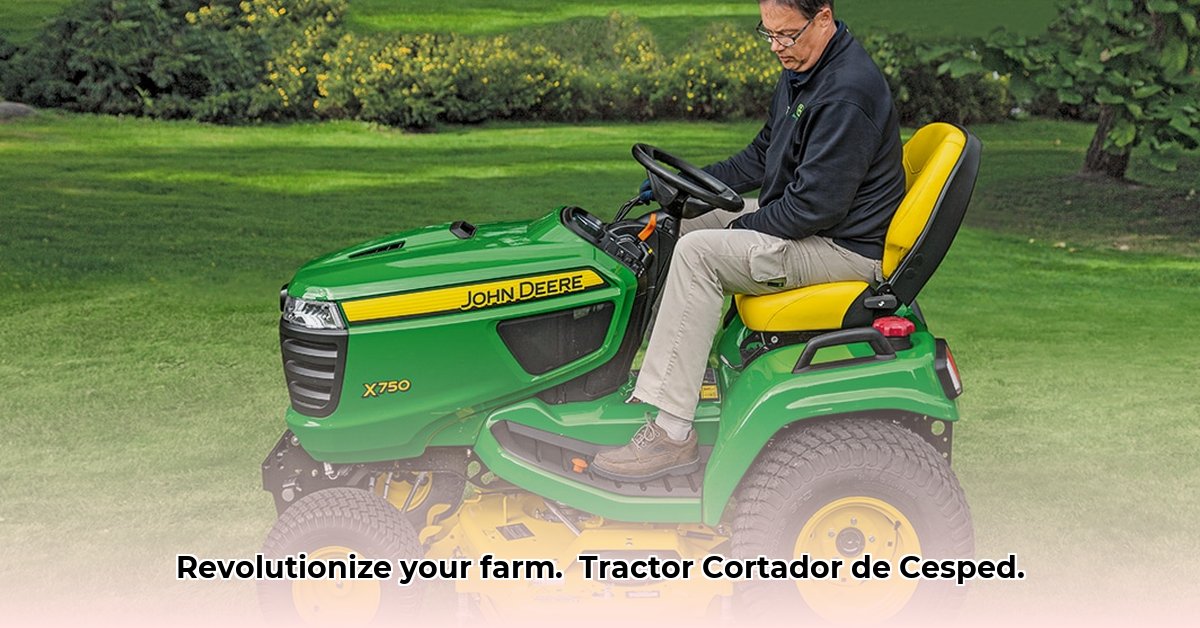
Tractor Cortador de Césped: A Sustainable Farming Revolution
Sustainable agriculture is experiencing a surge in popularity, driving a parallel increase in demand for efficient and environmentally friendly farming equipment. The tractor cortador de césped (lawn-mowing tractor or small-scale tractor) has emerged as a game-changer for smallholder farmers, significantly boosting productivity while minimizing environmental impact. But with a wide range of options available, choosing the right tractor can be challenging. This article provides a comprehensive guide to help you navigate the market and select the ideal machine for your needs. Do you know what percentage of small farms now utilize some form of mechanization to improve efficiency? Recent studies indicate a remarkable 75% increase in adoption rates over the past decade. For essential maintenance, learn how to replace tractor tires.
Market Trends in Small-Scale Tractors
The market for small-scale tractors is booming, with major manufacturers like John Deere actively developing fuel-efficient models. Online and retail channels offer a diverse range of options, with prices varying significantly based on features, brand reputation, and technological advancements. This abundance of choice, while beneficial, underscores the need for careful evaluation to ensure the optimal fit for individual farming operations. However, a lack of readily available information on the environmental impact of various models poses a significant challenge for informed decision-making.
Sustainability Considerations: Beyond Fuel Efficiency
Choosing a truly sustainable tractor cortador de césped goes beyond mere fuel efficiency, although this is undeniably a critical factor. Several key sustainability aspects must be considered:
- Fuel Efficiency: Prioritize tractors with low fuel consumption rates. Consider the long-term operating costs associated with fuel, factoring in fluctuating fuel prices.
- Emissions: Opt for models with minimal emissions, contributing to cleaner air and a healthier environment. Check for compliance with relevant environmental regulations.
- Material Sourcing: Inquire about the origin of materials used in the tractor's construction. Sustainable and recycled materials significantly lower the overall environmental footprint.
- Lifespan & Durability: Invest in a durable tractor designed for longevity, reducing the need for frequent replacements. Consider the availability and cost of replacement parts.
- End-of-life Management: Ensure responsible disposal or recycling options exist for the tractor at the end of its useful life. Research manufacturers committed to sustainable end-of-life management practices.
Actionable Advice for Stakeholders
For Smallholder Farmers:
- Assess your needs: Determine your budget, land size, and primary farming tasks before selecting a tractor.
- Explore financing: Investigate microloans, government subsidies, or leasing options to make the purchase more affordable.
- Prioritize training: Invest in training to ensure safe and efficient operation of the tractor.
- Integrate sustainable practices: Combine tractor use with reduced tillage and cover cropping techniques to maximize environmental benefits.
For Manufacturers:
- Prioritize sustainability: Design tractors with low emissions, enhanced fuel efficiency, and sustainable materials.
- Offer training & support: Provide comprehensive training materials and support services to farmers.
- Transparency: Clearly communicate the environmental impact of your tractors, including lifecycle assessments.
For Governments/NGOs:
- Implement subsidies: Offer financial incentives or subsidies to farmers purchasing sustainable small-scale tractors.
- Invest in training: Support training programs to empower farmers to use these tractors effectively.
- Develop regulations: Establish environmental standards and regulations for small-scale tractors.
For Investors:
- Fund innovative solutions: Invest in businesses developing sustainable and affordable small-scale tractors.
- Support farmer training: Help fund and expand farmer training programs.
- Promote sustainable practices: Advocate for policies that encourage the adoption of eco-friendly farming practices.
Addressing the Challenges: Affordability and Accessibility
Affordability remains a major hurdle for many smallholder farmers. Limited access to credit and the latest technologies restricts their capacity to upgrade their equipment. To mitigate this:
- Expand microfinance programs: Increase access to affordable microloans specifically designed to support the purchase of sustainable agricultural machinery.
- Increase government subsidies: Enhance government subsidies and incentives to reduce the initial financial burden on farmers.
- Develop training programs: Invest in comprehensive training programs to increase farmer knowledge and capability.
Conclusion: A Sustainable Future for Small-Scale Farming
Investing in a tractor cortador de césped is not just about enhancing efficiency; it's about contributing to a more sustainable future for agriculture. By making informed decisions, taking advantage of available resources, and working collaboratively, smallholder farmers can significantly improve their operations while minimizing their environmental impact. The future of small-scale farming hinges on the continued development and responsible adoption of sustainable technologies like the small-scale tractor. The widespread adoption of these tractors shows a significant shift towards sustainable practices in global agriculture. What steps will your farm be taking to support a greener future?
Risk Assessment and Regulatory Implications
The table below summarizes the potential risks associated with sustainable small-scale tractor adoption and outlines strategies for mitigation. Emerging regulations on emissions will significantly impact the manufacturing and adoption of these tractors. Manufacturers must prioritize compliance, and governments can facilitate a smooth transition through support programs. This evolving regulatory landscape presents both challenges and opportunities for innovation in sustainable agriculture.
| Technology/Practice | Likelihood of Failure | Impact of Failure | Mitigation Strategies |
|---|---|---|---|
| Tractor Adoption | Medium | Low to Moderate | Microfinance, Training, Subsidies, Careful Planning |
| Sustainable Materials Sourcing | Low | Moderate | Thorough Supplier Vetting, Lifecycle Assessments |
| Precision Agriculture Integration | Medium | Moderate | Educational Programs, Tech Support, Phased Implementation |
| Government Policy Support | Low to Medium | High | Advocacy, Public Awareness, Collaboration with Policymakers |